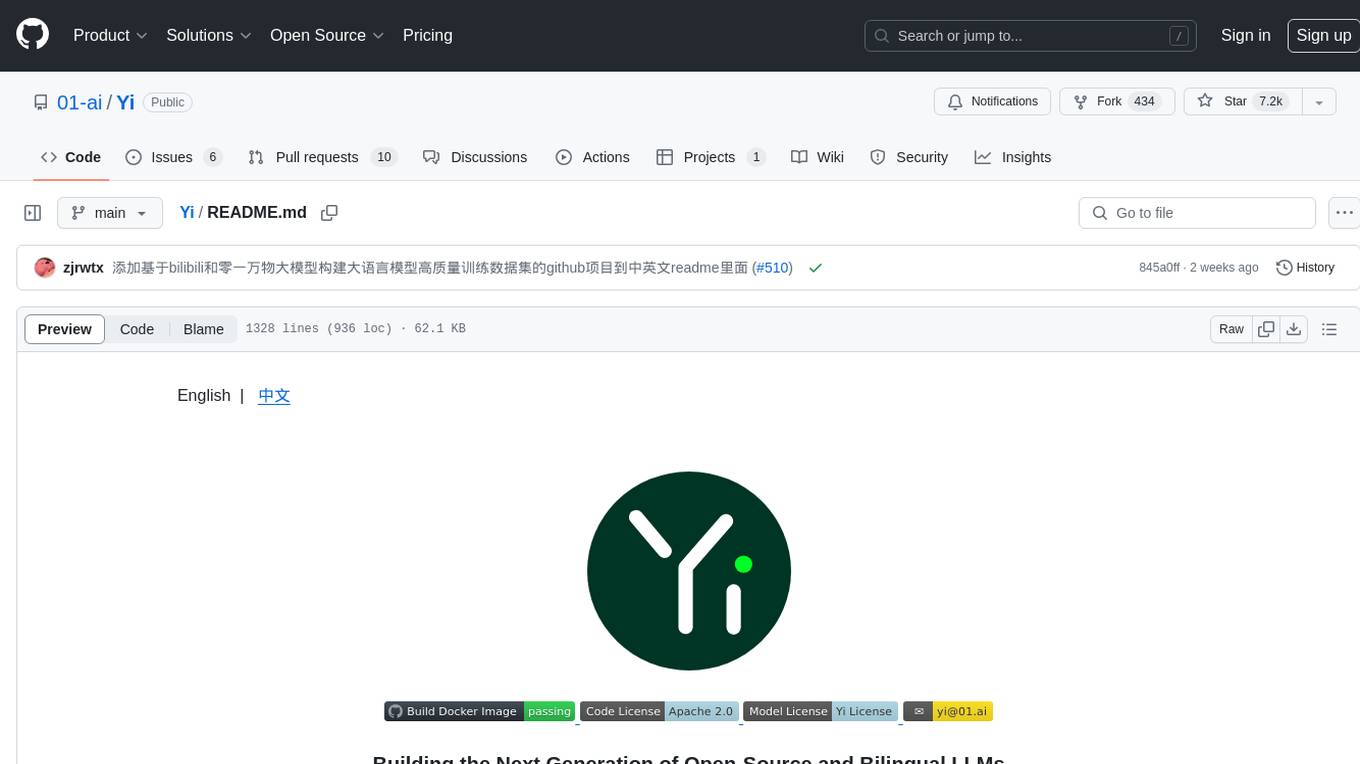
InternLM
Official release of InternLM series (InternLM, InternLM2, InternLM2.5, InternLM3).
Stars: 6718
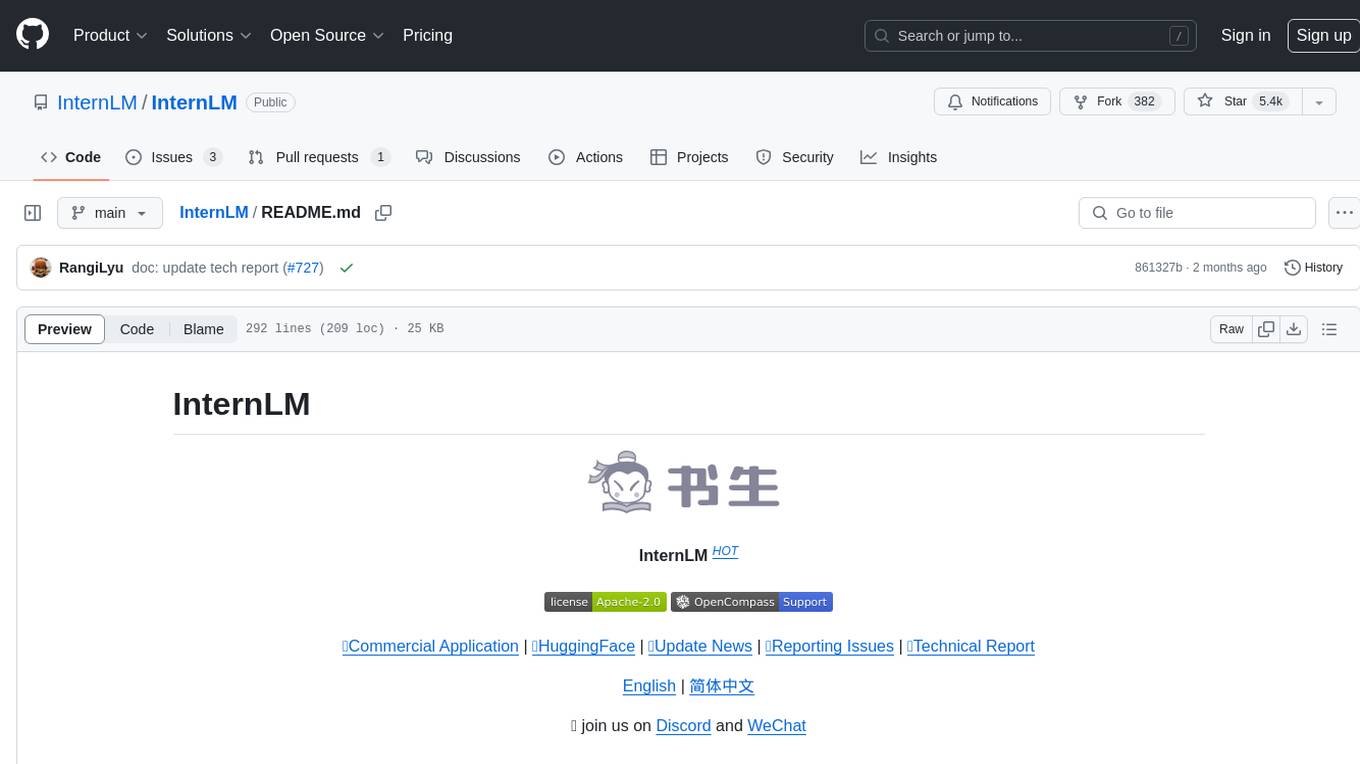
InternLM is a powerful language model series with features such as 200K context window for long-context tasks, outstanding comprehensive performance in reasoning, math, code, chat experience, instruction following, and creative writing, code interpreter & data analysis capabilities, and stronger tool utilization capabilities. It offers models in sizes of 7B and 20B, suitable for research and complex scenarios. The models are recommended for various applications and exhibit better performance than previous generations. InternLM models may match or surpass other open-source models like ChatGPT. The tool has been evaluated on various datasets and has shown superior performance in multiple tasks. It requires Python >= 3.8, PyTorch >= 1.12.0, and Transformers >= 4.34 for usage. InternLM can be used for tasks like chat, agent applications, fine-tuning, deployment, and long-context inference.
README:
📘Commercial Application |
🤗HuggingFace |
🆕Update News |
🤔Reporting Issues |
📜Technical Report
💬Chat Web |
🔗API |
🧩Modelers
👋 join us on Discord and WeChat
InternLM3 has open-sourced an 8-billion parameter instruction model, InternLM3-8B-Instruct, designed for general-purpose usage and advanced reasoning. This model has the following characteristics:
- Enhanced performance at reduced cost: State-of-the-art performance on reasoning and knowledge-intensive tasks surpass models like Llama3.1-8B and Qwen2.5-7B. Remarkably, InternLM3 is trained on only 4 trillion high-quality tokens, saving more than 75% of the training cost compared to other LLMs of similar scale.
- Deep thinking capability: InternLM3 supports both the deep thinking mode for solving complicated reasoning tasks via the long chain-of-thought and the normal response mode for fluent user interactions.
[2025.01.15] We release InternLM3-8B-Instruct, See model zoo below for download or model cards for more details.
[2024.08.01] We release InternLM2.5-1.8B, InternLM2.5-1.8B-Chat, InternLM2.5-20B and InternLM2.5-20B-Chat. See model zoo below for download or model cards for more details.
[2024.07.19] We release the InternLM2-Reward series of reward models in 1.8B, 7B and 20B sizes. See model zoo below for download or model cards for more details.
[2024.07.03] We release InternLM2.5-7B, InternLM2.5-7B-Chat and InternLM2.5-7B-Chat-1M. See model zoo below for download or model cards for more details.
[2024.03.26] We release InternLM2 technical report. See arXiv for details.
[2024.01.31] We release InternLM2-1.8B, along with the associated chat model. They provide a cheaper deployment option while maintaining leading performance.
[2024.01.23] We release InternLM2-Math-7B and InternLM2-Math-20B with pretraining and SFT checkpoints. They surpass ChatGPT with small sizes. See InternLM-Math for details and download.
[2024.01.17] We release InternLM2-7B and InternLM2-20B and their corresponding chat models with stronger capabilities in all dimensions. See model zoo below for download or model cards for more details.
[2023.12.13] InternLM-7B-Chat and InternLM-20B-Chat checkpoints are updated. With an improved finetuning strategy, the new chat models can generate higher quality responses with greater stylistic diversity.
[2023.09.20] InternLM-20B is released with base and chat versions.
| Model | Transformers | ModelScope | Modelers | Release Date |
|---|---|---|---|---|
| InternLM3-8B-Instruct | 🤗internlm3_8B_instruct |  internlm3_8b_instruct internlm3_8b_instruct |
2025-01-15 |
(click to expand)
| Model | Transformers(HF) | ModelScope(HF) | OpenXLab(HF) | OpenXLab(Origin) | Release Date |
|---|---|---|---|---|---|
| InternLM2.5-1.8B | 🤗internlm2_5-1_8b |  internlm2_5-1_8b internlm2_5-1_8b |
 |
 |
2024-08-05 |
| InternLM2.5-1.8B-Chat | 🤗internlm2_5-1_8b-chat |  internlm2_5-1_8b-chat internlm2_5-1_8b-chat |
 |
 |
2024-08-05 |
| InternLM2.5-7B | 🤗internlm2_5-7b |  internlm2_5-7b internlm2_5-7b |
 |
 |
2024-07-03 |
| InternLM2.5-7B-Chat | 🤗internlm2_5-7b-chat |  internlm2_5-7b-chat internlm2_5-7b-chat |
 |
 |
2024-07-03 |
| InternLM2.5-7B-Chat-1M | 🤗internlm2_5-7b-chat-1m |  internlm2_5-7b-chat-1m internlm2_5-7b-chat-1m |
 |
 |
2024-07-03 |
| InternLM2.5-20B | 🤗internlm2_5-20b |  internlm2_5-20b internlm2_5-20b |
 |
 |
2024-08-05 |
| InternLM2.5-20B-Chat | 🤗internlm2_5-20b-chat |  internlm2_5-20b-chat internlm2_5-20b-chat |
 |
 |
2024-08-05 |
Notes:
The release of InternLM2.5 series contains 1.8B, 7B, and 20B versions. 7B models are efficient for research and application and 20B models are more powerful and can support more complex scenarios. The relation of these models are shown as follows.
- InternLM2.5: Foundation models pre-trained on large-scale corpus. InternLM2.5 models are recommended for consideration in most applications.
- InternLM2.5-Chat: The Chat model that undergoes supervised fine-tuning (SFT) and reinforcement learning from human feedback (RLHF), based on the InternLM2.5 model. InternLM2.5-Chat is optimized for instruction following, chat experience, and function call, which is recommended for downstream applications.
- InternLM2.5-Chat-1M: InternLM2.5-Chat-1M supports 1M long-context with compatible performance as InternLM2.5-Chat.
Limitations: Although we have made efforts to ensure the safety of the model during the training process and to encourage the model to generate text that complies with ethical and legal requirements, the model may still produce unexpected outputs due to its size and probabilistic generation paradigm. For example, the generated responses may contain biases, discrimination, or other harmful content. Please do not propagate such content. We are not responsible for any consequences resulting from the dissemination of harmful information.
Supplements: HF refers to the format used by HuggingFace in transformers, whereas Origin denotes the format adopted by the InternLM team in InternEvo.
(click to expand)
InternLM2-Reward is a series of reward models, trained on 2.4 million preference samples, available in 1.8B, 7B, and 20B sizes. These model were applied to the PPO training process of our chat models. See model cards for more details.
| Model | RewardBench Score | Transformers(HF) | ModelScope(HF) | OpenXLab(HF) | Release Date |
|---|---|---|---|---|---|
| InternLM2-1.8B-Reward | 80.6 | 🤗internlm2-1_8b-reward |  internlm2-1_8b-reward internlm2-1_8b-reward |
 |
2024-07-19 |
| InternLM2-7B-Reward | 86.6 | 🤗internlm2-7b-reward |  internlm2-7b-reward internlm2-7b-reward |
 |
2024-07-19 |
| InternLM2-20B-Reward | 89.5 | 🤗internlm2-20b-reward |  internlm2-20b-reward internlm2-20b-reward |
 |
2024-07-19 |
(click to expand)
Our previous generation models with advanced capabilities in long-context processing, reasoning, and coding. See model cards for more details.
| Model | Transformers(HF) | ModelScope(HF) | OpenXLab(HF) | OpenXLab(Origin) | Release Date |
|---|---|---|---|---|---|
| InternLM2-1.8B | 🤗internlm2-1.8b |  internlm2-1.8b internlm2-1.8b |
 |
 |
2024-01-31 |
| InternLM2-Chat-1.8B-SFT | 🤗internlm2-chat-1.8b-sft |  internlm2-chat-1.8b-sft internlm2-chat-1.8b-sft |
 |
 |
2024-01-31 |
| InternLM2-Chat-1.8B | 🤗internlm2-chat-1.8b |  internlm2-chat-1.8b internlm2-chat-1.8b |
 |
 |
2024-02-19 |
| InternLM2-Base-7B | 🤗internlm2-base-7b |  internlm2-base-7b internlm2-base-7b |
 |
 |
2024-01-17 |
| InternLM2-7B | 🤗internlm2-7b |  internlm2-7b internlm2-7b |
 |
 |
2024-01-17 |
| InternLM2-Chat-7B-SFT | 🤗internlm2-chat-7b-sft |  internlm2-chat-7b-sft internlm2-chat-7b-sft |
 |
 |
2024-01-17 |
| InternLM2-Chat-7B | 🤗internlm2-chat-7b |  internlm2-chat-7b internlm2-chat-7b |
 |
 |
2024-01-17 |
| InternLM2-Base-20B | 🤗internlm2-base-20b |  internlm2-base-20b internlm2-base-20b |
 |
 |
2024-01-17 |
| InternLM2-20B | 🤗internlm2-20b |  internlm2-20b internlm2-20b |
 |
 |
2024-01-17 |
| InternLM2-Chat-20B-SFT | 🤗internlm2-chat-20b-sft |  internlm2-chat-20b-sft internlm2-chat-20b-sft |
 |
 |
2024-01-17 |
| InternLM2-Chat-20B | 🤗internlm2-chat-20b |  internlm2-chat-20b internlm2-chat-20b |
 |
 |
2024-01-17 |
We conducted a comprehensive evaluation of InternLM using the open-source evaluation tool OpenCompass. The evaluation covered five dimensions of capabilities: disciplinary competence, language competence, knowledge competence, inference competence, and comprehension competence. Here are some of the evaluation results, and you can visit the OpenCompass leaderboard for more evaluation results.
| Benchmark | InternLM3-8B-Instruct | Qwen2.5-7B-Instruct | Llama3.1-8B-Instruct | GPT-4o-mini(close source) | |
|---|---|---|---|---|---|
| General | CMMLU(0-shot) | 83.1 | 75.8 | 53.9 | 66.0 |
| MMLU(0-shot) | 76.6 | 76.8 | 71.8 | 82.7 | |
| MMLU-Pro(0-shot) | 57.6 | 56.2 | 48.1 | 64.1 | |
| Reasoning | GPQA-Diamond(0-shot) | 37.4 | 33.3 | 24.2 | 42.9 |
| DROP(0-shot) | 83.1 | 80.4 | 81.6 | 85.2 | |
| HellaSwag(10-shot) | 91.2 | 85.3 | 76.7 | 89.5 | |
| KOR-Bench(0-shot) | 56.4 | 44.6 | 47.7 | 58.2 | |
| MATH | MATH-500(0-shot) | 83.0* | 72.4 | 48.4 | 74.0 |
| AIME2024(0-shot) | 20.0* | 16.7 | 6.7 | 13.3 | |
| Coding | LiveCodeBench(2407-2409 Pass@1) | 17.8 | 16.8 | 12.9 | 21.8 |
| HumanEval(Pass@1) | 82.3 | 85.4 | 72.0 | 86.6 | |
| Instrunction | IFEval(Prompt-Strict) | 79.3 | 71.7 | 75.2 | 79.7 |
| Long Context | RULER(4-128K Average) | 87.9 | 81.4 | 88.5 | 90.7 |
| Chat | AlpacaEval 2.0(LC WinRate) | 51.1 | 30.3 | 25.0 | 50.7 |
| WildBench(Raw Score) | 33.1 | 23.3 | 1.5 | 40.3 | |
| MT-Bench-101(Score 1-10) | 8.59 | 8.49 | 8.37 | 8.87 |
- The evaluation results were obtained from OpenCompass (some data marked with *, which means evaluating with Thinking Mode), and evaluation configuration can be found in the configuration files provided by OpenCompass.
- The evaluation data may have numerical differences due to the version iteration of OpenCompass, so please refer to the latest evaluation results of OpenCompass. Limitations: Although we have made efforts to ensure the safety of the model during the training process and to encourage the model to generate text that complies with ethical and legal requirements, the model may still produce unexpected outputs due to its size and probabilistic generation paradigm. For example, the generated responses may contain biases, discrimination, or other harmful content. Please do not propagate such content. We are not responsible for any consequences resulting from the dissemination of harmful information.
- Python >= 3.8
- PyTorch >= 1.12.0 (2.0.0 and above are recommended)
- Transformers >= 4.38
To load the InternLM3 8B Instruct model using Transformers, use the following code:
import torch
from transformers import AutoTokenizer, AutoModelForCausalLM
model_dir = "internlm/internlm3-8b-instruct"
tokenizer = AutoTokenizer.from_pretrained(model_dir, trust_remote_code=True)
# Set `torch_dtype=torch.float16` to load model in float16, otherwise it will be loaded as float32 and might cause OOM Error.
model = AutoModelForCausalLM.from_pretrained(model_dir, trust_remote_code=True, torch_dtype=torch.float16)
# (Optional) If on low resource devices, you can load model in 4-bit or 8-bit to further save GPU memory via bitsandbytes.
# InternLM3 8B in 4bit will cost nearly 8GB GPU memory.
# pip install -U bitsandbytes
# 8-bit: model = AutoModelForCausalLM.from_pretrained(model_dir, device_map="auto", trust_remote_code=True, load_in_8bit=True)
# 4-bit: model = AutoModelForCausalLM.from_pretrained(model_dir, device_map="auto", trust_remote_code=True, load_in_4bit=True)
model = model.eval()
system_prompt = """You are an AI assistant whose name is InternLM (书生·浦语).
- InternLM (书生·浦语) is a conversational language model that is developed by Shanghai AI Laboratory (上海人工智能实验室). It is designed to be helpful, honest, and harmless.
- InternLM (书生·浦语) can understand and communicate fluently in the language chosen by the user such as English and 中文."""
messages = [
{"role": "system", "content": system_prompt},
{"role": "user", "content": "Please tell me five scenic spots in Shanghai"},
]
tokenized_chat = tokenizer.apply_chat_template(messages, tokenize=True, add_generation_prompt=True, return_tensors="pt")
generated_ids = model.generate(tokenized_chat, max_new_tokens=1024, temperature=1, repetition_penalty=1.005, top_k=40, top_p=0.8)
generated_ids = [
output_ids[len(input_ids):] for input_ids, output_ids in zip(tokenized_chat, generated_ids)
]
prompt = tokenizer.batch_decode(tokenized_chat)[0]
print(prompt)
response = tokenizer.batch_decode(generated_ids)[0]
print(response)LMDeploy is a toolkit for compressing, deploying, and serving LLM, developed by the MMRazor and MMDeploy teams.
pip install lmdeployYou can run batch inference locally with the following python code:
import lmdeploy
model_dir = "internlm/internlm3-8b-instruct"
pipe = lmdeploy.pipeline(model_dir)
response = pipe("Please tell me five scenic spots in Shanghai")
print(response)Or you can launch an OpenAI compatible server with the following command:
lmdeploy serve api_server internlm/internlm3-8b-instruct --model-name internlm3-8b-instruct --server-port 23333Then you can send a chat request to the server:
curl http://localhost:23333/v1/chat/completions \
-H "Content-Type: application/json" \
-d '{
"model": "internlm3-8b-instruct",
"messages": [
{"role": "user", "content": "Please tell me five scenic spots in Shanghai"}
]
}'Find more details in the LMDeploy documentation
pip3 install "sglang[srt]>=0.4.1.post6" --find-links https://flashinfer.ai/whl/cu124/torch2.4/flashinfer/python3 -m sglang.launch_server --model internlm/internlm3-8b-instruct --trust-remote-code --chat-template internlm2-chatimport openai
client = openai.Client(
base_url="http://127.0.0.1:30000/v1", api_key="EMPTY")
# Chat completion
response = client.chat.completions.create(
model="default",
messages=[
{"role": "system", "content": "You are a helpful AI assistant"},
{"role": "user", "content": "List 3 countries and their capitals."},
],
temperature=0,
max_tokens=64,
)
print(response)install ollama and pull the model
# install ollama
curl -fsSL https://ollama.com/install.sh | sh
# pull the model
ollama pull internlm/internlm3-8b-instruct
# install ollama-python
pip install ollamainference code:
import ollama
system_prompt = """You are an AI assistant whose name is InternLM (书生·浦语).
- InternLM (书生·浦语) is a conversational language model that is developed by Shanghai AI Laboratory (上海人工智能实验室). It is designed to be helpful, honest, and harmless.
- InternLM (书生·浦语) can understand and communicate fluently in the language chosen by the user such as English and 中文."""
messages = [
{
"role": "system",
"content": system_prompt,
},
{
"role": "user",
"content": "Please tell me five scenic spots in Shanghai"
},
]
stream = ollama.chat(
model='internlm/internlm3-8b-instruct',
messages=messages,
stream=True,
)
for chunk in stream:
print(chunk['message']['content'], end='', flush=True)refer to installation to install the latest code of vllm
pip install vllm --pre --extra-index-url https://wheels.vllm.ai/nightlyinference code:
from vllm import LLM, SamplingParams
llm = LLM(model="internlm/internlm3-8b-instruct")
sampling_params = SamplingParams(temperature=1, repetition_penalty=1.005, top_k=40, top_p=0.8)
system_prompt = """You are an AI assistant whose name is InternLM (书生·浦语).
- InternLM (书生·浦语) is a conversational language model that is developed by Shanghai AI Laboratory (上海人工智能实验室). It is designed to be helpful, honest, and harmless.
- InternLM (书生·浦语) can understand and communicate fluently in the language chosen by the user such as English and 中文."""
prompts = [
{
"role": "system",
"content": system_prompt,
},
{
"role": "user",
"content": "Please tell me five scenic spots in Shanghai"
},
]
outputs = llm.chat(prompts,
sampling_params=sampling_params,
use_tqdm=False)
print(outputs)thinking_system_prompt = """You are an expert mathematician with extensive experience in mathematical competitions. You approach problems through systematic thinking and rigorous reasoning. When solving problems, follow these thought processes:
## Deep Understanding
Take time to fully comprehend the problem before attempting a solution. Consider:
- What is the real question being asked?
- What are the given conditions and what do they tell us?
- Are there any special restrictions or assumptions?
- Which information is crucial and which is supplementary?
## Multi-angle Analysis
Before solving, conduct thorough analysis:
- What mathematical concepts and properties are involved?
- Can you recall similar classic problems or solution methods?
- Would diagrams or tables help visualize the problem?
- Are there special cases that need separate consideration?
## Systematic Thinking
Plan your solution path:
- Propose multiple possible approaches
- Analyze the feasibility and merits of each method
- Choose the most appropriate method and explain why
- Break complex problems into smaller, manageable steps
## Rigorous Proof
During the solution process:
- Provide solid justification for each step
- Include detailed proofs for key conclusions
- Pay attention to logical connections
- Be vigilant about potential oversights
## Repeated Verification
After completing your solution:
- Verify your results satisfy all conditions
- Check for overlooked special cases
- Consider if the solution can be optimized or simplified
- Review your reasoning process
Remember:
1. Take time to think thoroughly rather than rushing to an answer
2. Rigorously prove each key conclusion
3. Keep an open mind and try different approaches
4. Summarize valuable problem-solving methods
5. Maintain healthy skepticism and verify multiple times
Your response should reflect deep mathematical understanding and precise logical thinking, making your solution path and reasoning clear to others.
When you're ready, present your complete solution with:
- Clear problem understanding
- Detailed solution process
- Key insights
- Thorough verification
Focus on clear, logical progression of ideas and thorough explanation of your mathematical reasoning. Provide answers in the same language as the user asking the question, repeat the final answer using a '\\boxed{}' without any units, you have [[8192]] tokens to complete the answer.
"""import torch
from transformers import AutoTokenizer, AutoModelForCausalLM
model_dir = "internlm/internlm3-8b-instruct"
tokenizer = AutoTokenizer.from_pretrained(model_dir, trust_remote_code=True)
# Set `torch_dtype=torch.float16` to load model in float16, otherwise it will be loaded as float32 and might cause OOM Error.
model = AutoModelForCausalLM.from_pretrained(model_dir, trust_remote_code=True, torch_dtype=torch.float16)
# (Optional) If on low resource devices, you can load model in 4-bit or 8-bit to further save GPU memory via bitsandbytes.
# InternLM3 8B in 4bit will cost nearly 8GB GPU memory.
# pip install -U bitsandbytes
# 8-bit: model = AutoModelForCausalLM.from_pretrained(model_dir, device_map="auto", trust_remote_code=True, load_in_8bit=True)
# 4-bit: model = AutoModelForCausalLM.from_pretrained(model_dir, device_map="auto", trust_remote_code=True, load_in_4bit=True)
model = model.eval()
messages = [
{"role": "system", "content": thinking_system_prompt},
{"role": "user", "content": "Given the function\(f(x)=\mathrm{e}^{x}-ax - a^{3}\),\n(1) When \(a = 1\), find the equation of the tangent line to the curve \(y = f(x)\) at the point \((1,f(1))\).\n(2) If \(f(x)\) has a local minimum and the minimum value is less than \(0\), determine the range of values for \(a\)."},
]
tokenized_chat = tokenizer.apply_chat_template(messages, tokenize=True, add_generation_prompt=True, return_tensors="pt")
generated_ids = model.generate(tokenized_chat, max_new_tokens=8192)
generated_ids = [
output_ids[len(input_ids):] for input_ids, output_ids in zip(tokenized_chat, generated_ids)
]
prompt = tokenizer.batch_decode(tokenized_chat)[0]
print(prompt)
response = tokenizer.batch_decode(generated_ids)[0]
print(response)LMDeploy is a toolkit for compressing, deploying, and serving LLM.
pip install lmdeployYou can run batch inference locally with the following python code:
from lmdeploy import pipeline, GenerationConfig, ChatTemplateConfig
model_dir = "internlm/internlm3-8b-instruct"
chat_template_config = ChatTemplateConfig(model_name='internlm3')
pipe = pipeline(model_dir, chat_template_config=chat_template_config)
messages = [
{"role": "system", "content": thinking_system_prompt},
{"role": "user", "content": "Given the function\(f(x)=\mathrm{e}^{x}-ax - a^{3}\),\n(1) When \(a = 1\), find the equation of the tangent line to the curve \(y = f(x)\) at the point \((1,f(1))\).\n(2) If \(f(x)\) has a local minimum and the minimum value is less than \(0\), determine the range of values for \(a\)."},
]
response = pipe(messages, gen_config=GenerationConfig(max_new_tokens=2048))
print(response)Installation
pip3 install "sglang[srt]>=0.4.1.post6" --find-links https://flashinfer.ai/whl/cu124/torch2.4/flashinfer/For offline engine api usage, please refer to Offline Engine API
install ollama and pull the model
# install ollama
curl -fsSL https://ollama.com/install.sh | sh
# pull the model
ollama pull internlm/internlm3-8b-instruct
# install ollama-python
pip install ollamainference code:
import ollama
messages = [
{
"role": "system",
"content": thinking_system_prompt,
},
{
"role": "user",
"content": "已知函数\(f(x)=\mathrm{e}^{x}-ax - a^{3}\)。\n(1)当\(a = 1\)时,求曲线\(y = f(x)\)在点\((1,f(1))\)处的切线方程;\n(2)若\(f(x)\)有极小值,且极小值小于\(0\),求\(a\)的取值范围。"
},
]
stream = ollama.chat(
model='internlm/internlm3-8b-instruct',
messages=messages,
stream=True,
options=dict(num_ctx=8192, num_predict=2048)
)
for chunk in stream:
print(chunk['message']['content'], end='', flush=True)refer to installation to install the latest code of vllm
pip install vllm --pre --extra-index-url https://wheels.vllm.ai/nightlyinference code
from vllm import LLM, SamplingParams
llm = LLM(model="internlm/internlm3-8b-instruct")
sampling_params = SamplingParams(temperature=1, repetition_penalty=1.005, top_k=40, top_p=0.8, max_tokens=8192)
prompts = [
{
"role": "system",
"content": thinking_system_prompt,
},
{
"role": "user",
"content": "Given the function\(f(x)=\mathrm{e}^{x}-ax - a^{3}\),\n(1) When \(a = 1\), find the equation of the tangent line to the curve \(y = f(x)\) at the point \((1,f(1))\).\n(2) If \(f(x)\) has a local minimum and the minimum value is less than \(0\), determine the range of values for \(a\)."
},
]
outputs = llm.chat(prompts,
sampling_params=sampling_params,
use_tqdm=False)
print(outputs)Code and model weights are licensed under Apache-2.0.
@misc{cai2024internlm2,
title={InternLM2 Technical Report},
author={Zheng Cai and Maosong Cao and Haojiong Chen and Kai Chen and Keyu Chen and Xin Chen and Xun Chen and Zehui Chen and Zhi Chen and Pei Chu and Xiaoyi Dong and Haodong Duan and Qi Fan and Zhaoye Fei and Yang Gao and Jiaye Ge and Chenya Gu and Yuzhe Gu and Tao Gui and Aijia Guo and Qipeng Guo and Conghui He and Yingfan Hu and Ting Huang and Tao Jiang and Penglong Jiao and Zhenjiang Jin and Zhikai Lei and Jiaxing Li and Jingwen Li and Linyang Li and Shuaibin Li and Wei Li and Yining Li and Hongwei Liu and Jiangning Liu and Jiawei Hong and Kaiwen Liu and Kuikun Liu and Xiaoran Liu and Chengqi Lv and Haijun Lv and Kai Lv and Li Ma and Runyuan Ma and Zerun Ma and Wenchang Ning and Linke Ouyang and Jiantao Qiu and Yuan Qu and Fukai Shang and Yunfan Shao and Demin Song and Zifan Song and Zhihao Sui and Peng Sun and Yu Sun and Huanze Tang and Bin Wang and Guoteng Wang and Jiaqi Wang and Jiayu Wang and Rui Wang and Yudong Wang and Ziyi Wang and Xingjian Wei and Qizhen Weng and Fan Wu and Yingtong Xiong and Chao Xu and Ruiliang Xu and Hang Yan and Yirong Yan and Xiaogui Yang and Haochen Ye and Huaiyuan Ying and Jia Yu and Jing Yu and Yuhang Zang and Chuyu Zhang and Li Zhang and Pan Zhang and Peng Zhang and Ruijie Zhang and Shuo Zhang and Songyang Zhang and Wenjian Zhang and Wenwei Zhang and Xingcheng Zhang and Xinyue Zhang and Hui Zhao and Qian Zhao and Xiaomeng Zhao and Fengzhe Zhou and Zaida Zhou and Jingming Zhuo and Yicheng Zou and Xipeng Qiu and Yu Qiao and Dahua Lin},
year={2024},
eprint={2403.17297},
archivePrefix={arXiv},
primaryClass={cs.CL}
}
For Tasks:
Click tags to check more tools for each tasksFor Jobs:
Alternative AI tools for InternLM
Similar Open Source Tools

InternLM
InternLM is a powerful language model series with features such as 200K context window for long-context tasks, outstanding comprehensive performance in reasoning, math, code, chat experience, instruction following, and creative writing, code interpreter & data analysis capabilities, and stronger tool utilization capabilities. It offers models in sizes of 7B and 20B, suitable for research and complex scenarios. The models are recommended for various applications and exhibit better performance than previous generations. InternLM models may match or surpass other open-source models like ChatGPT. The tool has been evaluated on various datasets and has shown superior performance in multiple tasks. It requires Python >= 3.8, PyTorch >= 1.12.0, and Transformers >= 4.34 for usage. InternLM can be used for tasks like chat, agent applications, fine-tuning, deployment, and long-context inference.
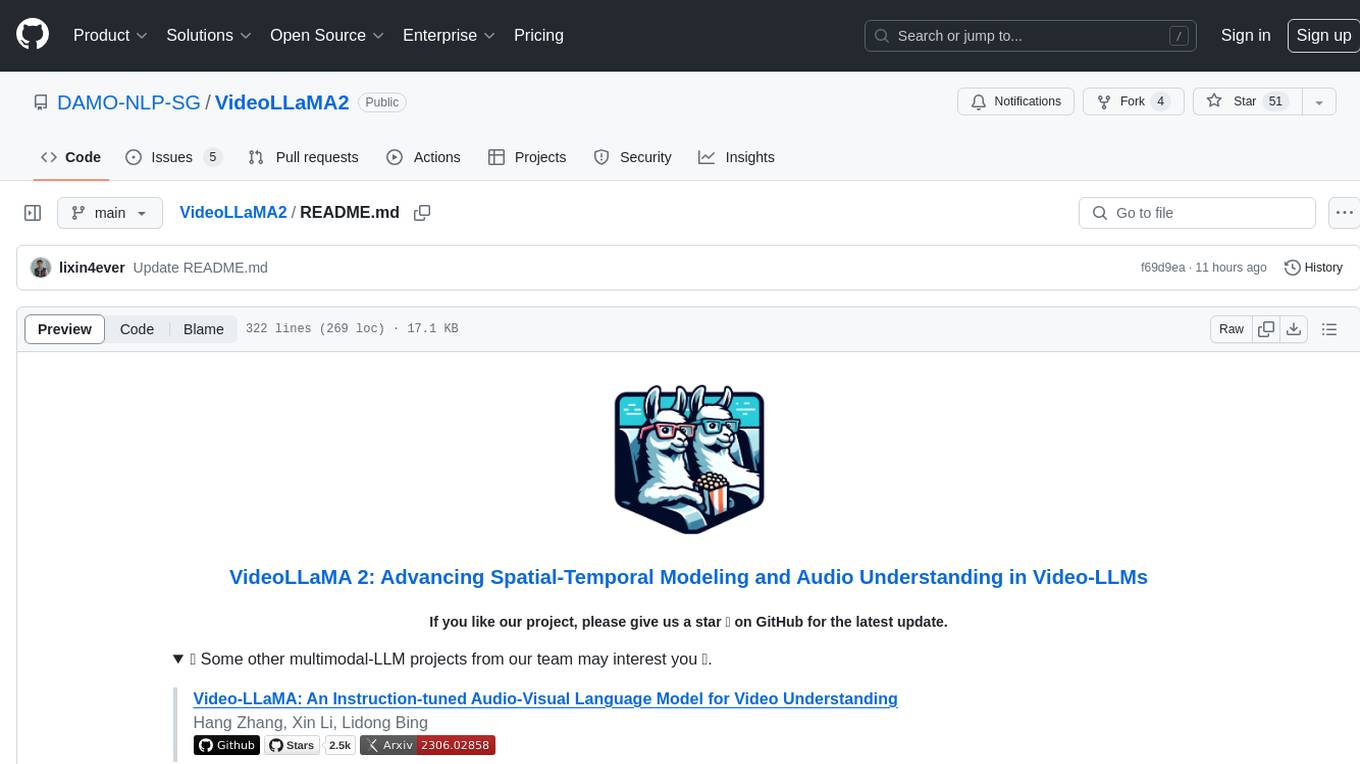
VideoLLaMA2
VideoLLaMA 2 is a project focused on advancing spatial-temporal modeling and audio understanding in video-LLMs. It provides tools for multi-choice video QA, open-ended video QA, and video captioning. The project offers model zoo with different configurations for visual encoder and language decoder. It includes training and evaluation guides, as well as inference capabilities for video and image processing. The project also features a demo setup for running a video-based Large Language Model web demonstration.
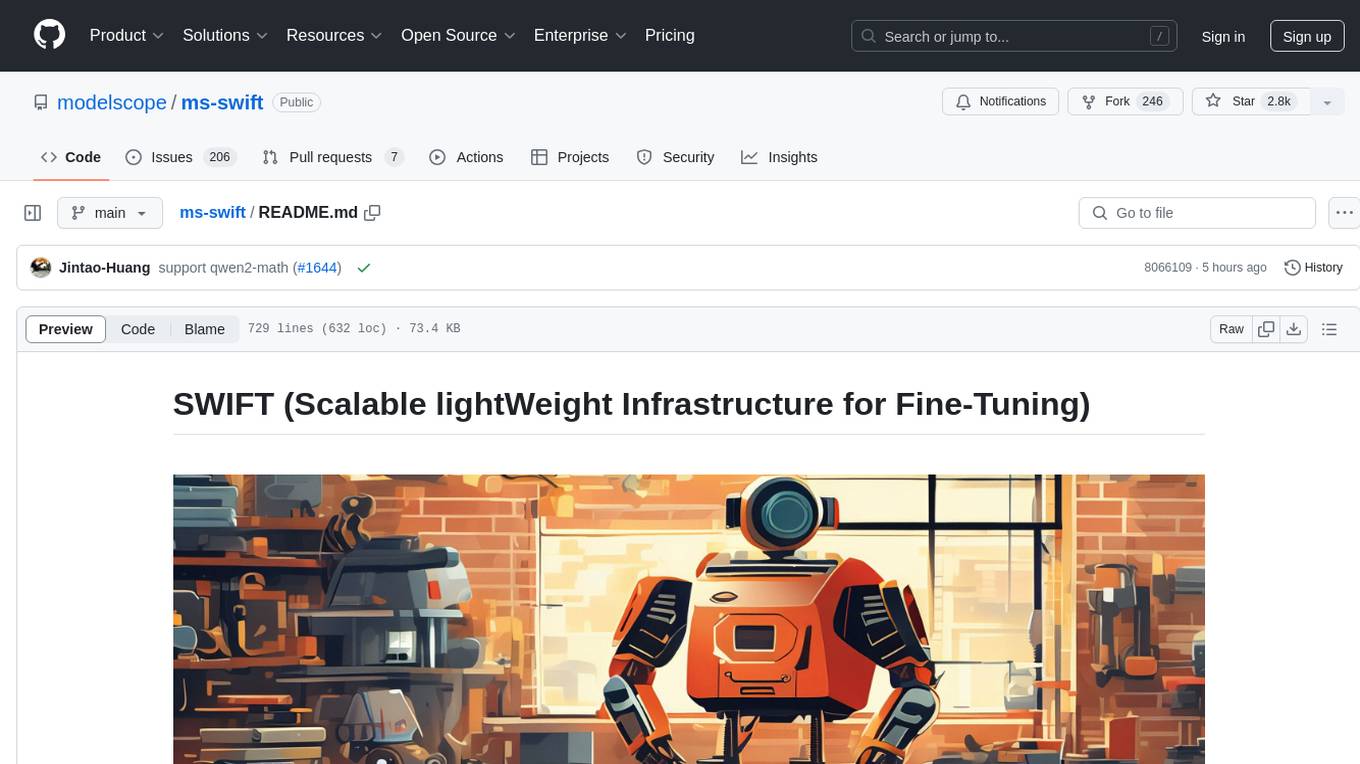
ms-swift
ms-swift is an official framework provided by the ModelScope community for fine-tuning and deploying large language models and multi-modal large models. It supports training, inference, evaluation, quantization, and deployment of over 400 large models and 100+ multi-modal large models. The framework includes various training technologies and accelerates inference, evaluation, and deployment modules. It offers a Gradio-based Web-UI interface and best practices for easy application of large models. ms-swift supports a wide range of model types, dataset types, hardware support, lightweight training methods, distributed training techniques, quantization training, RLHF training, multi-modal training, interface training, plugin and extension support, inference acceleration engines, model evaluation, and model quantization.
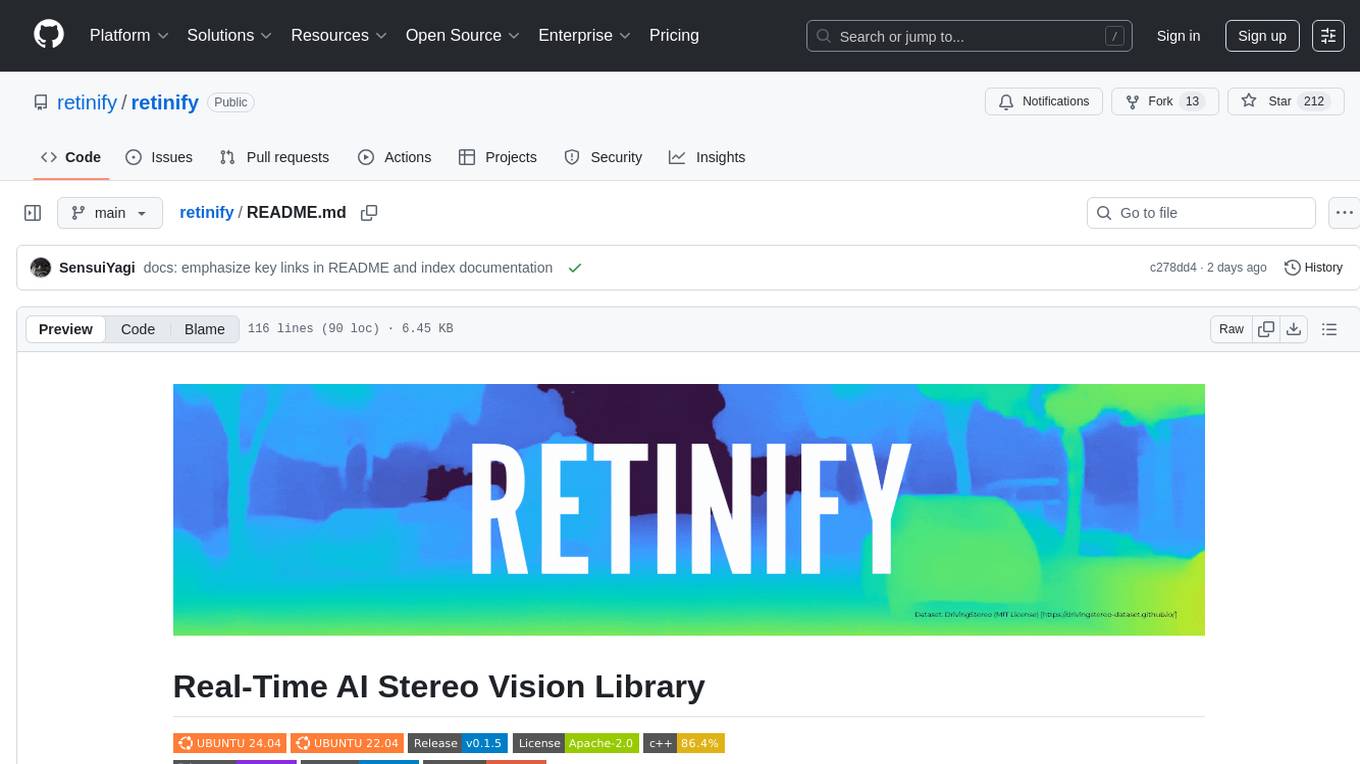
retinify
Retinify is an advanced AI-powered stereo vision library designed for robotics, enabling real-time, high-precision 3D perception by leveraging GPU and NPU acceleration. It is open source under Apache-2.0 license, offers high precision 3D mapping and object recognition, runs computations on GPU for fast performance, accepts stereo images from any rectified camera setup, is cost-efficient using minimal hardware, and has minimal dependencies on CUDA Toolkit, cuDNN, and TensorRT. The tool provides a pipeline for stereo matching and supports various image data types independently of OpenCV.
helicone
Helicone is an open-source observability platform designed for Language Learning Models (LLMs). It logs requests to OpenAI in a user-friendly UI, offers caching, rate limits, and retries, tracks costs and latencies, provides a playground for iterating on prompts and chat conversations, supports collaboration, and will soon have APIs for feedback and evaluation. The platform is deployed on Cloudflare and consists of services like Web (NextJs), Worker (Cloudflare Workers), Jawn (Express), Supabase, and ClickHouse. Users can interact with Helicone locally by setting up the required services and environment variables. The platform encourages contributions and provides resources for learning, documentation, and integrations.
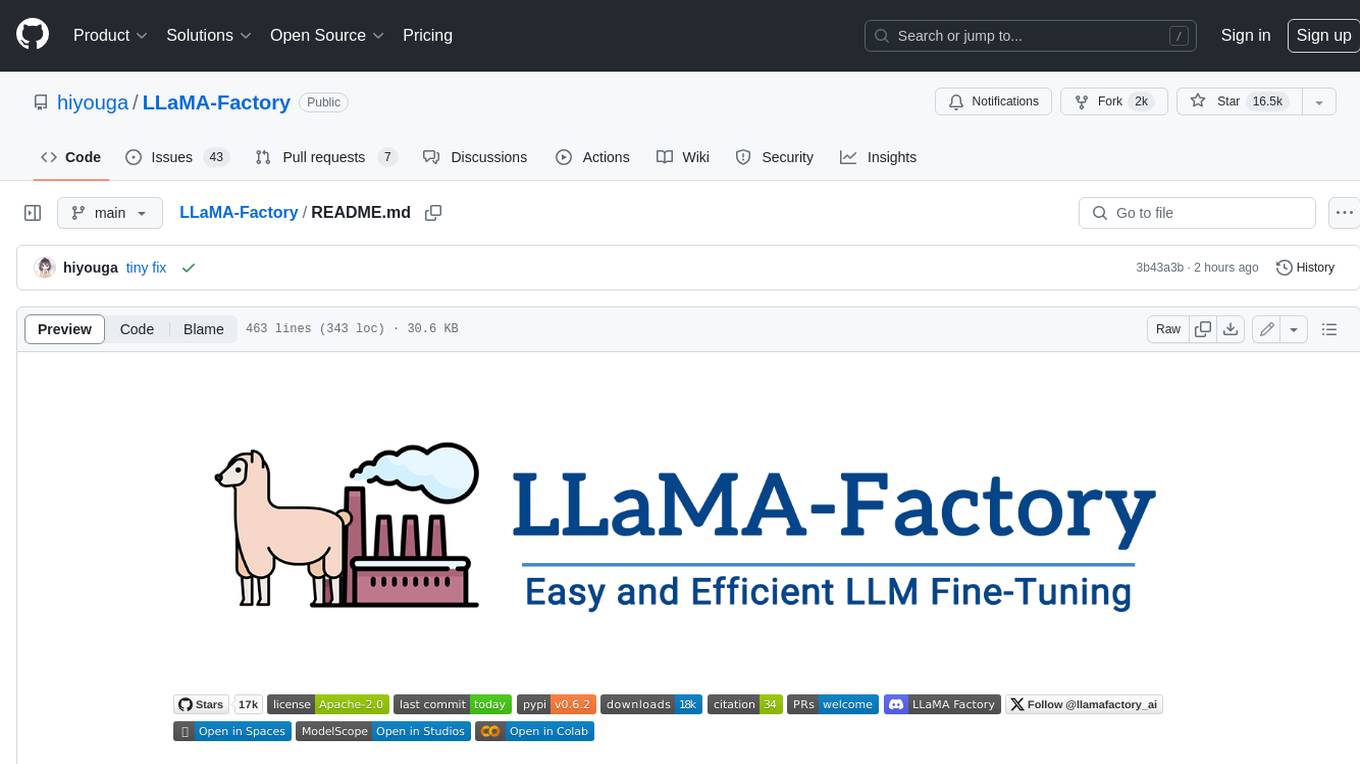
LLaMA-Factory
LLaMA Factory is a unified framework for fine-tuning 100+ large language models (LLMs) with various methods, including pre-training, supervised fine-tuning, reward modeling, PPO, DPO and ORPO. It features integrated algorithms like GaLore, BAdam, DoRA, LongLoRA, LLaMA Pro, LoRA+, LoftQ and Agent tuning, as well as practical tricks like FlashAttention-2, Unsloth, RoPE scaling, NEFTune and rsLoRA. LLaMA Factory provides experiment monitors like LlamaBoard, TensorBoard, Wandb, MLflow, etc., and supports faster inference with OpenAI-style API, Gradio UI and CLI with vLLM worker. Compared to ChatGLM's P-Tuning, LLaMA Factory's LoRA tuning offers up to 3.7 times faster training speed with a better Rouge score on the advertising text generation task. By leveraging 4-bit quantization technique, LLaMA Factory's QLoRA further improves the efficiency regarding the GPU memory.
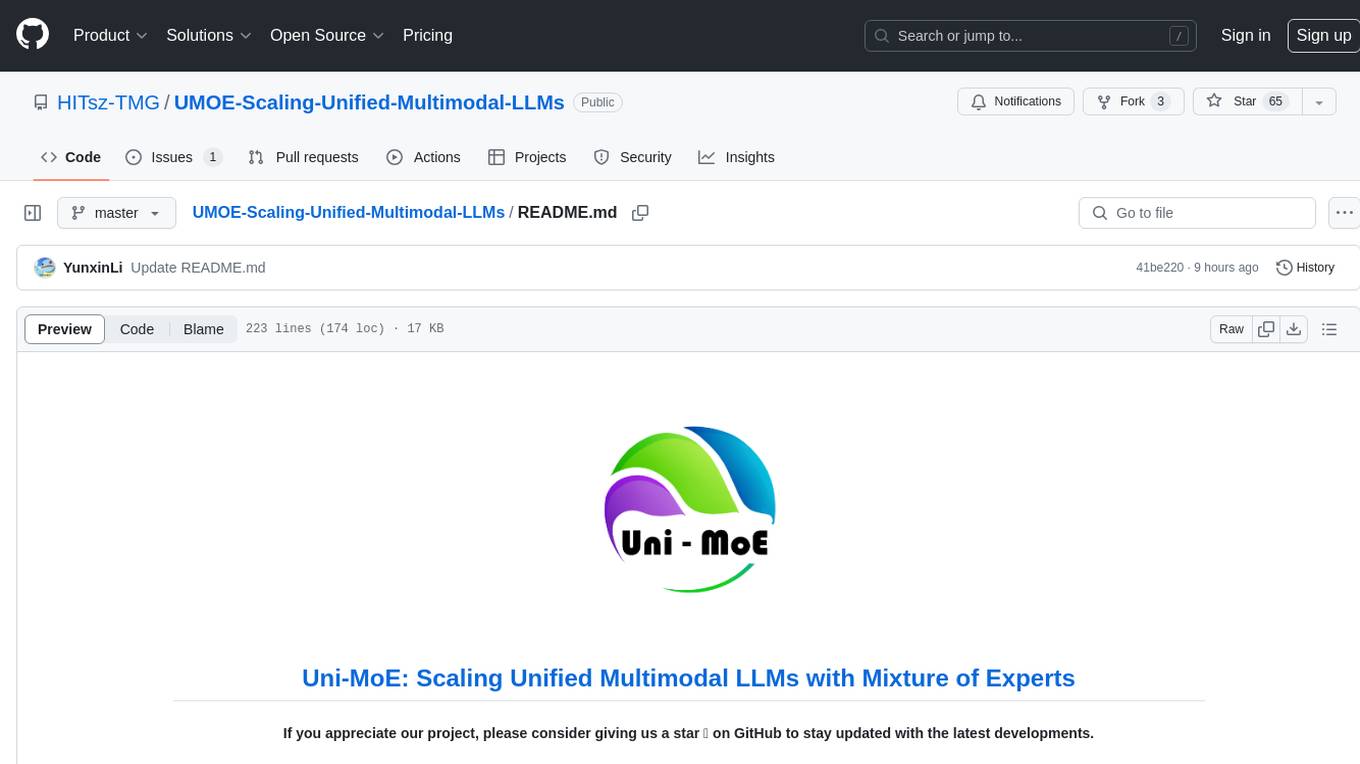
UMOE-Scaling-Unified-Multimodal-LLMs
Uni-MoE is a MoE-based unified multimodal model that can handle diverse modalities including audio, speech, image, text, and video. The project focuses on scaling Unified Multimodal LLMs with a Mixture of Experts framework. It offers enhanced functionality for training across multiple nodes and GPUs, as well as parallel processing at both the expert and modality levels. The model architecture involves three training stages: building connectors for multimodal understanding, developing modality-specific experts, and incorporating multiple trained experts into LLMs using the LoRA technique on mixed multimodal data. The tool provides instructions for installation, weights organization, inference, training, and evaluation on various datasets.

intel-extension-for-transformers
Intel® Extension for Transformers is an innovative toolkit designed to accelerate GenAI/LLM everywhere with the optimal performance of Transformer-based models on various Intel platforms, including Intel Gaudi2, Intel CPU, and Intel GPU. The toolkit provides the below key features and examples: * Seamless user experience of model compressions on Transformer-based models by extending [Hugging Face transformers](https://github.com/huggingface/transformers) APIs and leveraging [Intel® Neural Compressor](https://github.com/intel/neural-compressor) * Advanced software optimizations and unique compression-aware runtime (released with NeurIPS 2022's paper [Fast Distilbert on CPUs](https://arxiv.org/abs/2211.07715) and [QuaLA-MiniLM: a Quantized Length Adaptive MiniLM](https://arxiv.org/abs/2210.17114), and NeurIPS 2021's paper [Prune Once for All: Sparse Pre-Trained Language Models](https://arxiv.org/abs/2111.05754)) * Optimized Transformer-based model packages such as [Stable Diffusion](examples/huggingface/pytorch/text-to-image/deployment/stable_diffusion), [GPT-J-6B](examples/huggingface/pytorch/text-generation/deployment), [GPT-NEOX](examples/huggingface/pytorch/language-modeling/quantization#2-validated-model-list), [BLOOM-176B](examples/huggingface/pytorch/language-modeling/inference#BLOOM-176B), [T5](examples/huggingface/pytorch/summarization/quantization#2-validated-model-list), [Flan-T5](examples/huggingface/pytorch/summarization/quantization#2-validated-model-list), and end-to-end workflows such as [SetFit-based text classification](docs/tutorials/pytorch/text-classification/SetFit_model_compression_AGNews.ipynb) and [document level sentiment analysis (DLSA)](workflows/dlsa) * [NeuralChat](intel_extension_for_transformers/neural_chat), a customizable chatbot framework to create your own chatbot within minutes by leveraging a rich set of [plugins](https://github.com/intel/intel-extension-for-transformers/blob/main/intel_extension_for_transformers/neural_chat/docs/advanced_features.md) such as [Knowledge Retrieval](./intel_extension_for_transformers/neural_chat/pipeline/plugins/retrieval/README.md), [Speech Interaction](./intel_extension_for_transformers/neural_chat/pipeline/plugins/audio/README.md), [Query Caching](./intel_extension_for_transformers/neural_chat/pipeline/plugins/caching/README.md), and [Security Guardrail](./intel_extension_for_transformers/neural_chat/pipeline/plugins/security/README.md). This framework supports Intel Gaudi2/CPU/GPU. * [Inference](https://github.com/intel/neural-speed/tree/main) of Large Language Model (LLM) in pure C/C++ with weight-only quantization kernels for Intel CPU and Intel GPU (TBD), supporting [GPT-NEOX](https://github.com/intel/neural-speed/tree/main/neural_speed/models/gptneox), [LLAMA](https://github.com/intel/neural-speed/tree/main/neural_speed/models/llama), [MPT](https://github.com/intel/neural-speed/tree/main/neural_speed/models/mpt), [FALCON](https://github.com/intel/neural-speed/tree/main/neural_speed/models/falcon), [BLOOM-7B](https://github.com/intel/neural-speed/tree/main/neural_speed/models/bloom), [OPT](https://github.com/intel/neural-speed/tree/main/neural_speed/models/opt), [ChatGLM2-6B](https://github.com/intel/neural-speed/tree/main/neural_speed/models/chatglm), [GPT-J-6B](https://github.com/intel/neural-speed/tree/main/neural_speed/models/gptj), and [Dolly-v2-3B](https://github.com/intel/neural-speed/tree/main/neural_speed/models/gptneox). Support AMX, VNNI, AVX512F and AVX2 instruction set. We've boosted the performance of Intel CPUs, with a particular focus on the 4th generation Intel Xeon Scalable processor, codenamed [Sapphire Rapids](https://www.intel.com/content/www/us/en/products/docs/processors/xeon-accelerated/4th-gen-xeon-scalable-processors.html).
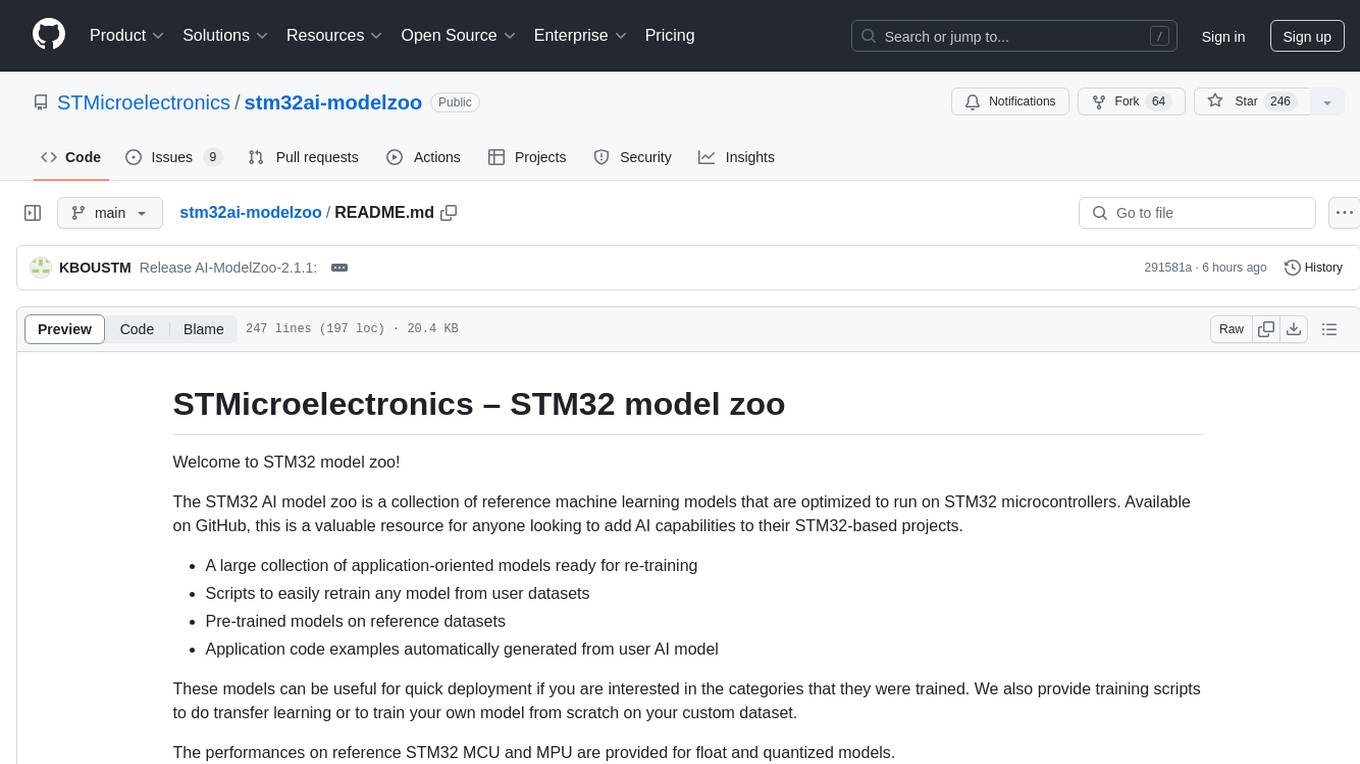
stm32ai-modelzoo
The STM32 AI model zoo is a collection of reference machine learning models optimized to run on STM32 microcontrollers. It provides a large collection of application-oriented models ready for re-training, scripts for easy retraining from user datasets, pre-trained models on reference datasets, and application code examples generated from user AI models. The project offers training scripts for transfer learning or training custom models from scratch. It includes performances on reference STM32 MCU and MPU for float and quantized models. The project is organized by application, providing step-by-step guides for training and deploying models.
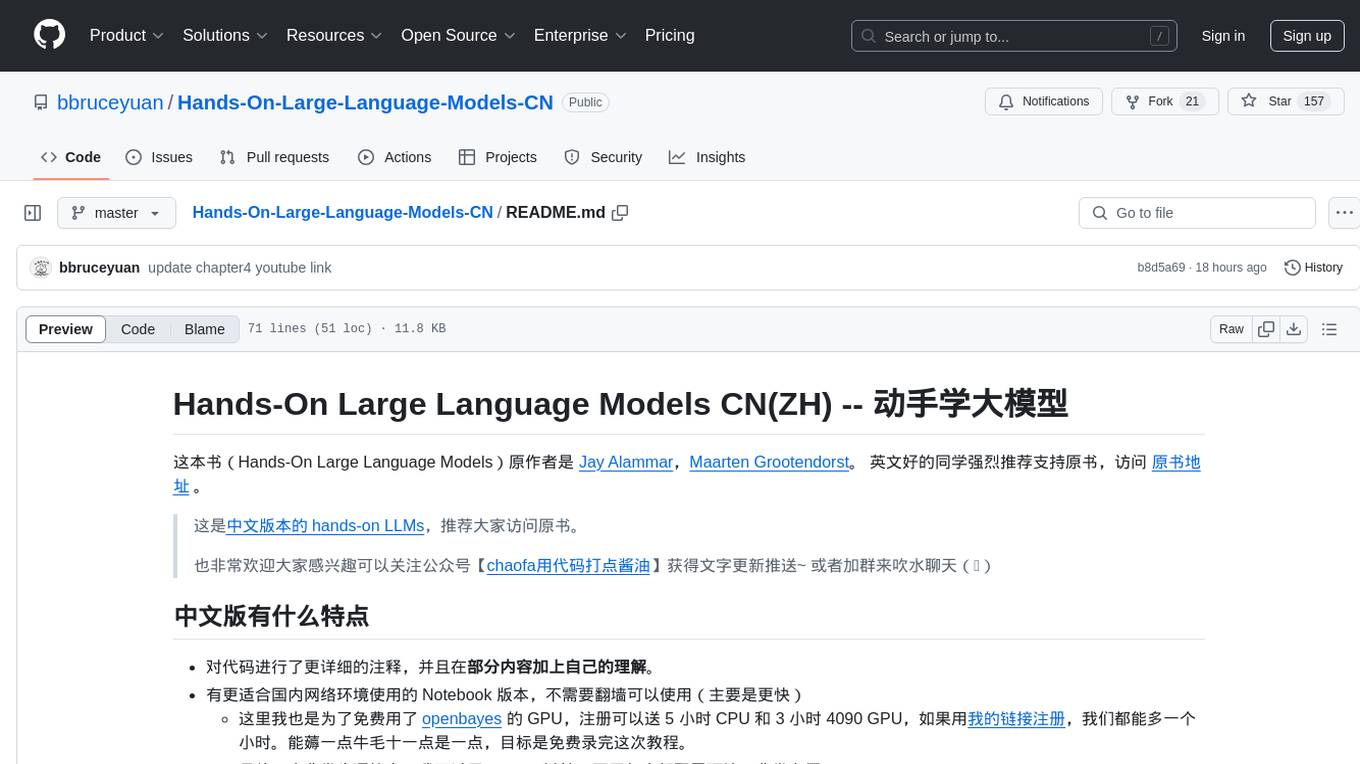
Hands-On-Large-Language-Models-CN
Hands-On Large Language Models CN(ZH) is a Chinese version of the book 'Hands-On Large Language Models' by Jay Alammar and Maarten Grootendorst. It provides detailed code annotations and additional insights, offers Notebook versions suitable for Chinese network environments, utilizes openbayes for free GPU access, allows convenient environment setup with vscode, and includes accompanying Chinese language videos on platforms like Bilibili and YouTube. The book covers various chapters on topics like Tokens and Embeddings, Transformer LLMs, Text Classification, Text Clustering, Prompt Engineering, Text Generation, Semantic Search, Multimodal LLMs, Text Embedding Models, Fine-tuning Models, and more.
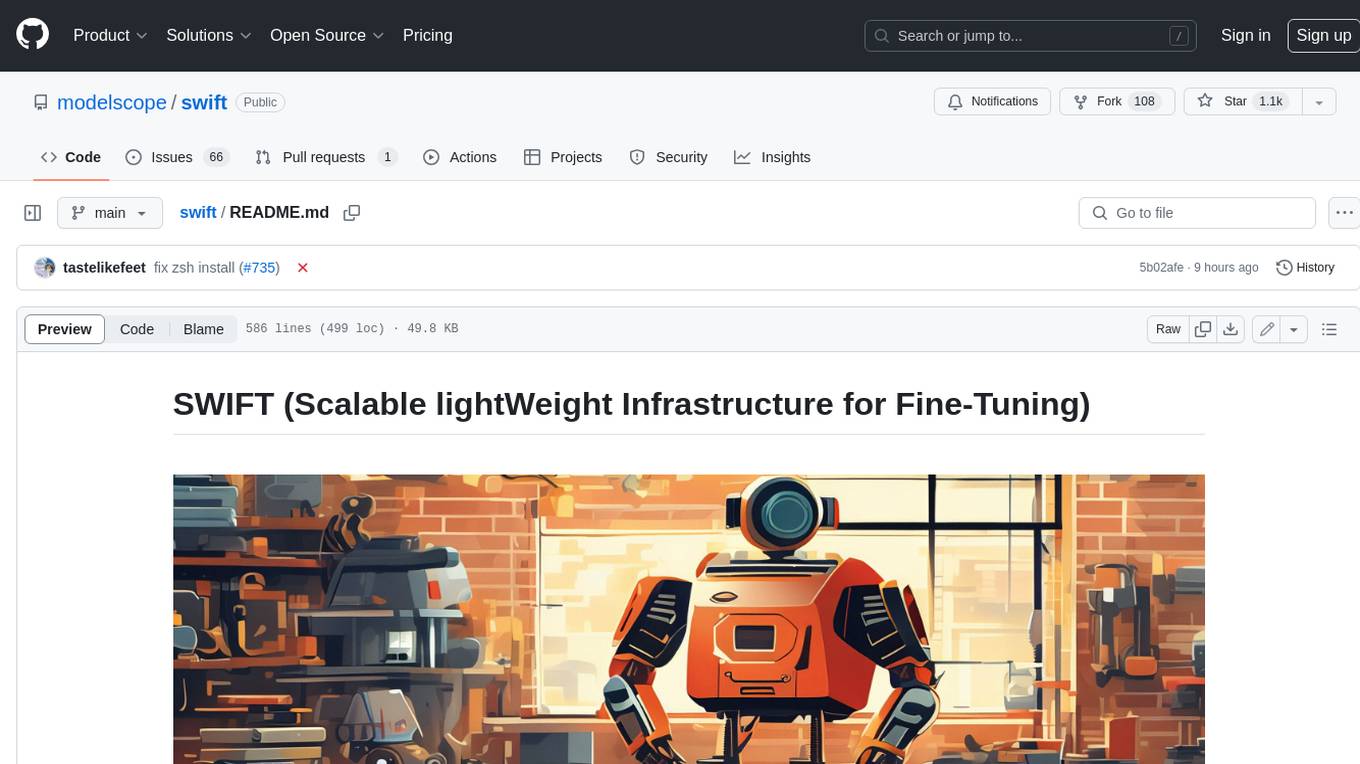
swift
SWIFT (Scalable lightWeight Infrastructure for Fine-Tuning) supports training, inference, evaluation and deployment of nearly **200 LLMs and MLLMs** (multimodal large models). Developers can directly apply our framework to their own research and production environments to realize the complete workflow from model training and evaluation to application. In addition to supporting the lightweight training solutions provided by [PEFT](https://github.com/huggingface/peft), we also provide a complete **Adapters library** to support the latest training techniques such as NEFTune, LoRA+, LLaMA-PRO, etc. This adapter library can be used directly in your own custom workflow without our training scripts. To facilitate use by users unfamiliar with deep learning, we provide a Gradio web-ui for controlling training and inference, as well as accompanying deep learning courses and best practices for beginners. Additionally, we are expanding capabilities for other modalities. Currently, we support full-parameter training and LoRA training for AnimateDiff.
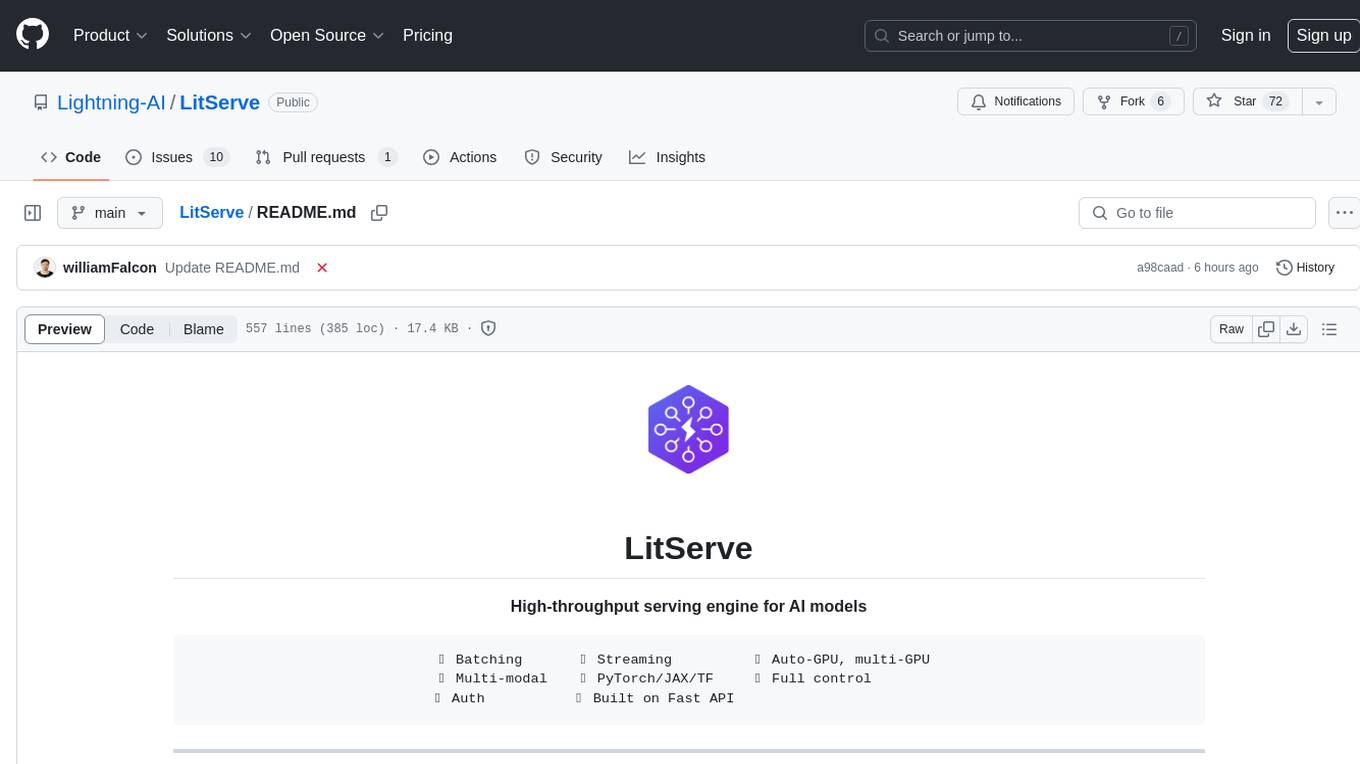
LitServe
LitServe is a high-throughput serving engine designed for deploying AI models at scale. It generates an API endpoint for models, handles batching, streaming, and autoscaling across CPU/GPUs. LitServe is built for enterprise scale with a focus on minimal, hackable code-base without bloat. It supports various model types like LLMs, vision, time-series, and works with frameworks like PyTorch, JAX, Tensorflow, and more. The tool allows users to focus on model performance rather than serving boilerplate, providing full control and flexibility.

TTS-WebUI
TTS WebUI is a comprehensive tool for text-to-speech synthesis, audio/music generation, and audio conversion. It offers a user-friendly interface for various AI projects related to voice and audio processing. The tool provides a range of models and extensions for different tasks, along with integrations like Silly Tavern and OpenWebUI. With support for Docker setup and compatibility with Linux and Windows, TTS WebUI aims to facilitate creative and responsible use of AI technologies in a user-friendly manner.
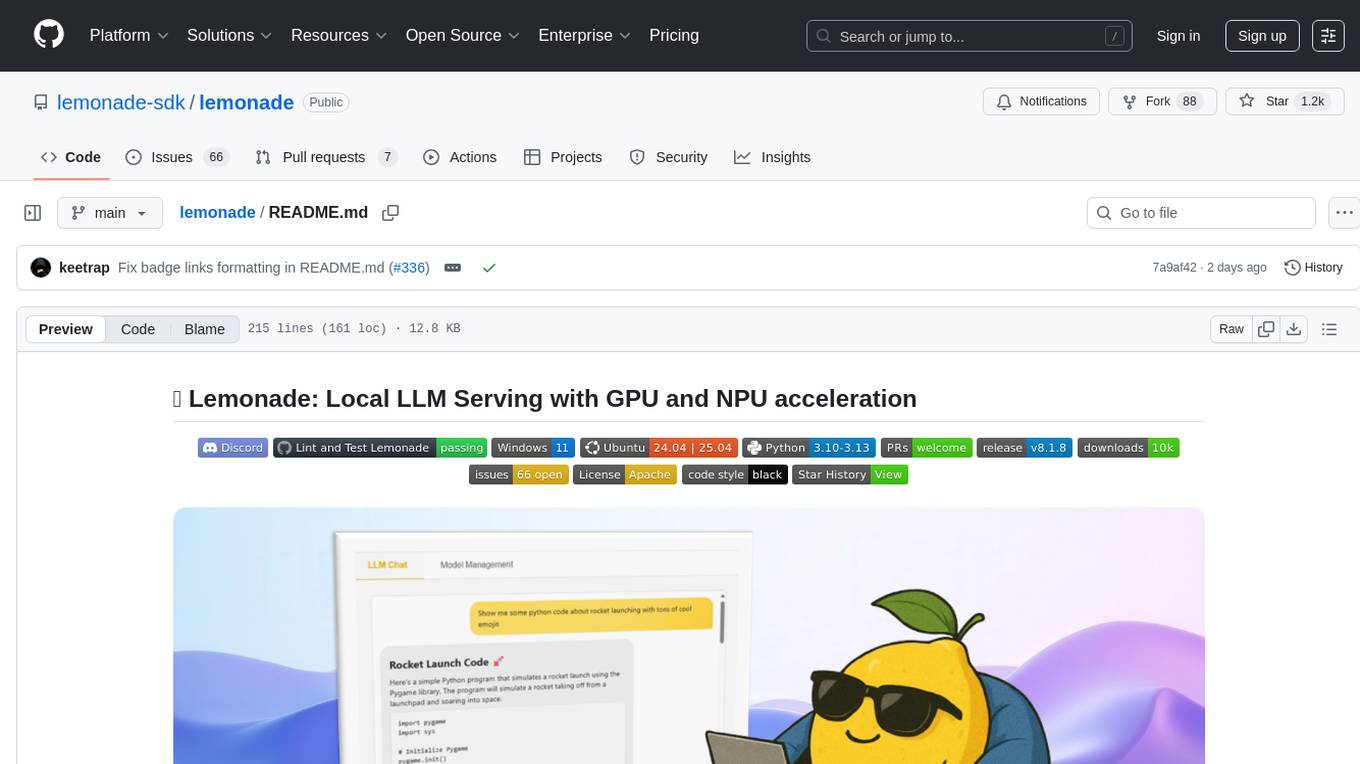
lemonade
Lemonade is a tool that helps users run local Large Language Models (LLMs) with high performance by configuring state-of-the-art inference engines for their Neural Processing Units (NPUs) and Graphics Processing Units (GPUs). It is used by startups, research teams, and large companies to run LLMs efficiently. Lemonade provides a high-level Python API for direct integration of LLMs into Python applications and a CLI for mixing and matching LLMs with various features like prompting templates, accuracy testing, performance benchmarking, and memory profiling. The tool supports both GGUF and ONNX models and allows importing custom models from Hugging Face using the Model Manager. Lemonade is designed to be easy to use and switch between different configurations at runtime, making it a versatile tool for running LLMs locally.
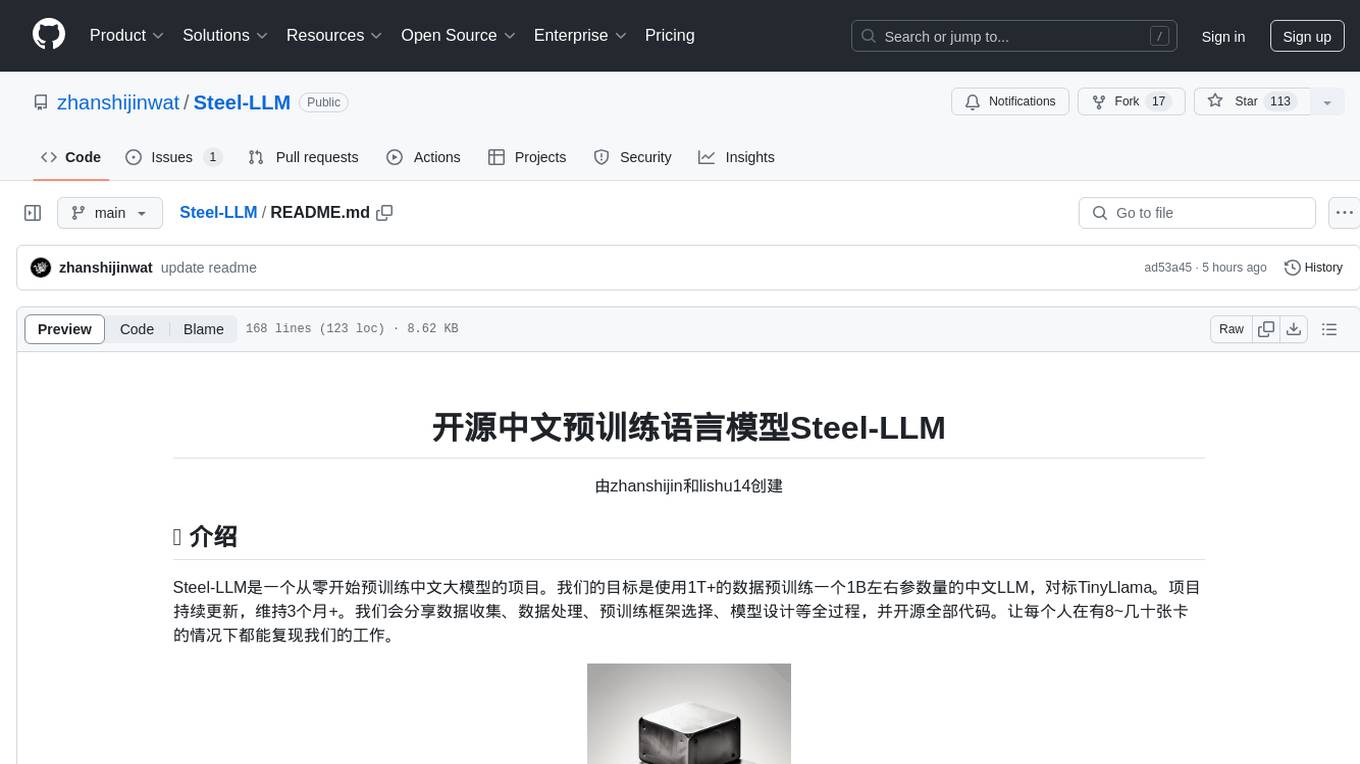
Steel-LLM
Steel-LLM is a project to pre-train a large Chinese language model from scratch using over 1T of data to achieve a parameter size of around 1B, similar to TinyLlama. The project aims to share the entire process including data collection, data processing, pre-training framework selection, model design, and open-source all the code. The goal is to enable reproducibility of the work even with limited resources. The name 'Steel' is inspired by a band '万能青年旅店' and signifies the desire to create a strong model despite limited conditions. The project involves continuous data collection of various cultural elements, trivia, lyrics, niche literature, and personal secrets to train the LLM. The ultimate aim is to fill the model with diverse data and leave room for individual input, fostering collaboration among users.
For similar tasks

Azure-Analytics-and-AI-Engagement
The Azure-Analytics-and-AI-Engagement repository provides packaged Industry Scenario DREAM Demos with ARM templates (Containing a demo web application, Power BI reports, Synapse resources, AML Notebooks etc.) that can be deployed in a customer’s subscription using the CAPE tool within a matter of few hours. Partners can also deploy DREAM Demos in their own subscriptions using DPoC.
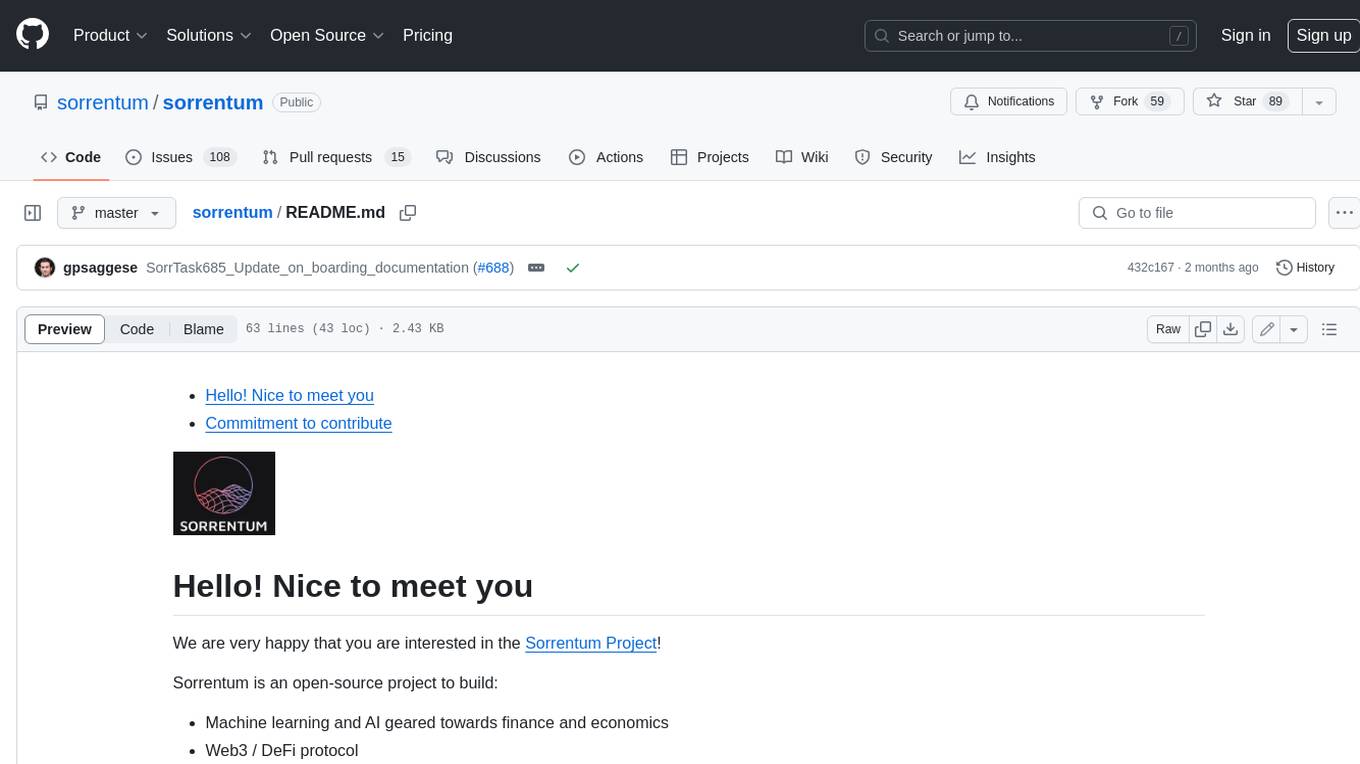
sorrentum
Sorrentum is an open-source project that aims to combine open-source development, startups, and brilliant students to build machine learning, AI, and Web3 / DeFi protocols geared towards finance and economics. The project provides opportunities for internships, research assistantships, and development grants, as well as the chance to work on cutting-edge problems, learn about startups, write academic papers, and get internships and full-time positions at companies working on Sorrentum applications.

tidb
TiDB is an open-source distributed SQL database that supports Hybrid Transactional and Analytical Processing (HTAP) workloads. It is MySQL compatible and features horizontal scalability, strong consistency, and high availability.

zep-python
Zep is an open-source platform for building and deploying large language model (LLM) applications. It provides a suite of tools and services that make it easy to integrate LLMs into your applications, including chat history memory, embedding, vector search, and data enrichment. Zep is designed to be scalable, reliable, and easy to use, making it a great choice for developers who want to build LLM-powered applications quickly and easily.

telemetry-airflow
This repository codifies the Airflow cluster that is deployed at workflow.telemetry.mozilla.org (behind SSO) and commonly referred to as "WTMO" or simply "Airflow". Some links relevant to users and developers of WTMO: * The `dags` directory in this repository contains some custom DAG definitions * Many of the DAGs registered with WTMO don't live in this repository, but are instead generated from ETL task definitions in bigquery-etl * The Data SRE team maintains a WTMO Developer Guide (behind SSO)
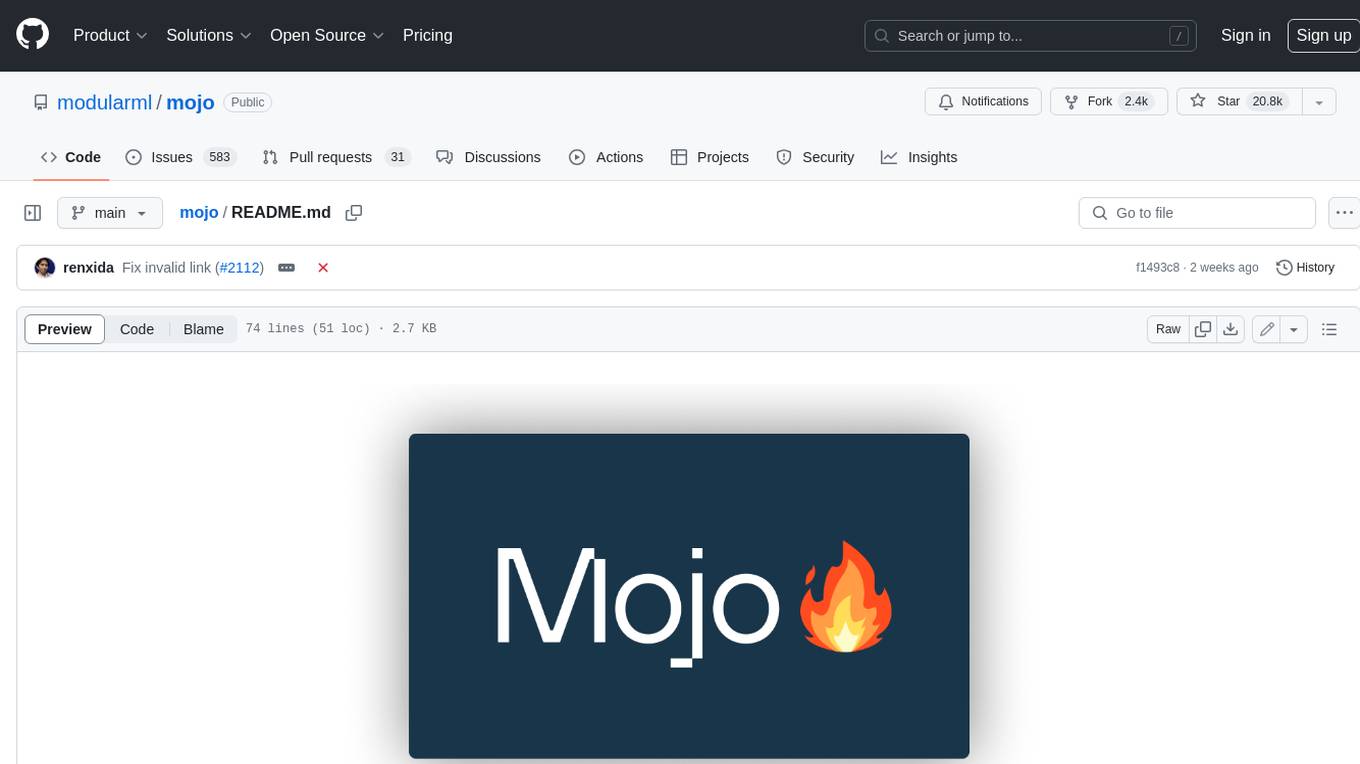
mojo
Mojo is a new programming language that bridges the gap between research and production by combining Python syntax and ecosystem with systems programming and metaprogramming features. Mojo is still young, but it is designed to become a superset of Python over time.
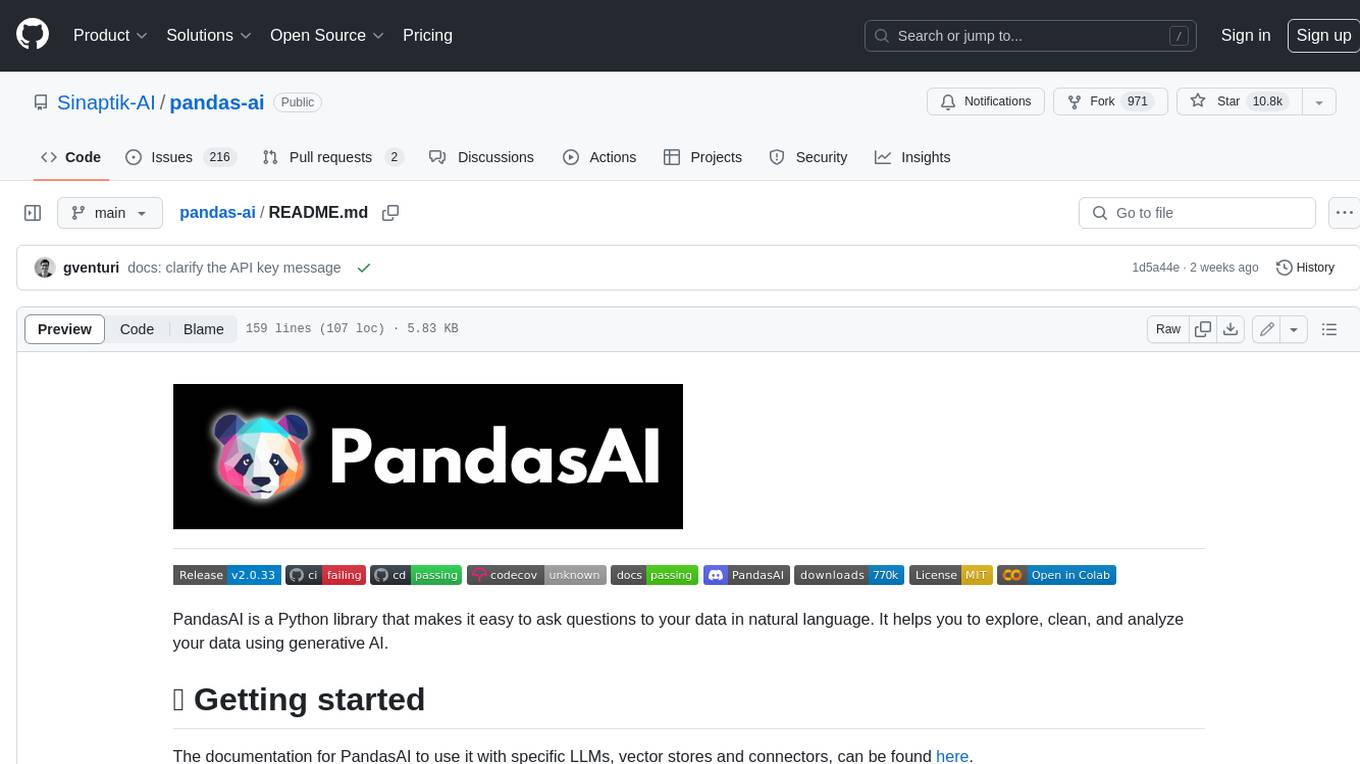
pandas-ai
PandasAI is a Python library that makes it easy to ask questions to your data in natural language. It helps you to explore, clean, and analyze your data using generative AI.

databend
Databend is an open-source cloud data warehouse that serves as a cost-effective alternative to Snowflake. With its focus on fast query execution and data ingestion, it's designed for complex analysis of the world's largest datasets.
For similar jobs

sweep
Sweep is an AI junior developer that turns bugs and feature requests into code changes. It automatically handles developer experience improvements like adding type hints and improving test coverage.

teams-ai
The Teams AI Library is a software development kit (SDK) that helps developers create bots that can interact with Teams and Microsoft 365 applications. It is built on top of the Bot Framework SDK and simplifies the process of developing bots that interact with Teams' artificial intelligence capabilities. The SDK is available for JavaScript/TypeScript, .NET, and Python.

ai-guide
This guide is dedicated to Large Language Models (LLMs) that you can run on your home computer. It assumes your PC is a lower-end, non-gaming setup.

classifai
Supercharge WordPress Content Workflows and Engagement with Artificial Intelligence. Tap into leading cloud-based services like OpenAI, Microsoft Azure AI, Google Gemini and IBM Watson to augment your WordPress-powered websites. Publish content faster while improving SEO performance and increasing audience engagement. ClassifAI integrates Artificial Intelligence and Machine Learning technologies to lighten your workload and eliminate tedious tasks, giving you more time to create original content that matters.

chatbot-ui
Chatbot UI is an open-source AI chat app that allows users to create and deploy their own AI chatbots. It is easy to use and can be customized to fit any need. Chatbot UI is perfect for businesses, developers, and anyone who wants to create a chatbot.

BricksLLM
BricksLLM is a cloud native AI gateway written in Go. Currently, it provides native support for OpenAI, Anthropic, Azure OpenAI and vLLM. BricksLLM aims to provide enterprise level infrastructure that can power any LLM production use cases. Here are some use cases for BricksLLM: * Set LLM usage limits for users on different pricing tiers * Track LLM usage on a per user and per organization basis * Block or redact requests containing PIIs * Improve LLM reliability with failovers, retries and caching * Distribute API keys with rate limits and cost limits for internal development/production use cases * Distribute API keys with rate limits and cost limits for students

uAgents
uAgents is a Python library developed by Fetch.ai that allows for the creation of autonomous AI agents. These agents can perform various tasks on a schedule or take action on various events. uAgents are easy to create and manage, and they are connected to a fast-growing network of other uAgents. They are also secure, with cryptographically secured messages and wallets.

griptape
Griptape is a modular Python framework for building AI-powered applications that securely connect to your enterprise data and APIs. It offers developers the ability to maintain control and flexibility at every step. Griptape's core components include Structures (Agents, Pipelines, and Workflows), Tasks, Tools, Memory (Conversation Memory, Task Memory, and Meta Memory), Drivers (Prompt and Embedding Drivers, Vector Store Drivers, Image Generation Drivers, Image Query Drivers, SQL Drivers, Web Scraper Drivers, and Conversation Memory Drivers), Engines (Query Engines, Extraction Engines, Summary Engines, Image Generation Engines, and Image Query Engines), and additional components (Rulesets, Loaders, Artifacts, Chunkers, and Tokenizers). Griptape enables developers to create AI-powered applications with ease and efficiency.

